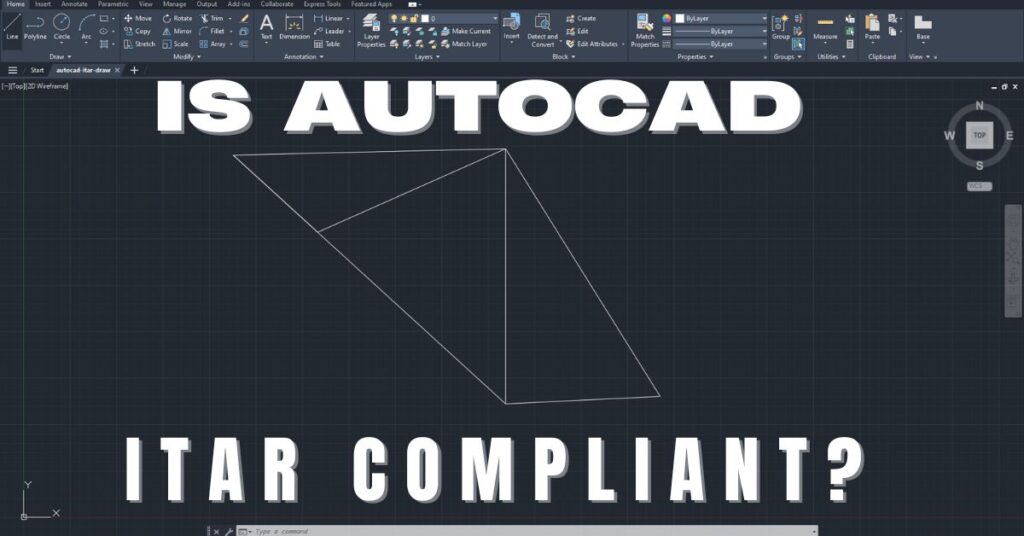Effective Compliance with ITAR, CMMC 2.0, and CUI: Navigating Microsoft 365 and DOD Guidelines
In the complex world of defense contracting and international trade, understanding and adhering to regulatory compliance is not just a best practice—it’s an absolute necessity. To this end, there are three critical compliance standards: International Traffic in Arms Regulations (ITAR), Cybersecurity Maturity Model Certification (CMMC 2.0), and Controlled Unclassified Information (CUI). These regulations play pivotal roles in maintaining national security and protecting sensitive information. It ensures that companies engaged in defense and related industries operate within legal and ethical standards. Are you interested in defense contracting or dealing in export-controlled items? You can leverage Microsoft GCC High 365 to support your compliance efforts. Use its various offerings like Microsoft G3, G5, GCC High, Outlook, and PowerApps.
ITAR, a set of U.S. government regulations, controls the export and import of defense-related articles and services. CMMC 2.0 is a tiered cybersecurity framework required for all defense contractors to safeguard sensitive defense information. CUI encompasses a range of sensitive information that, although not classified, must be adequately protected under federal laws and policies. In the wake of rampant data breaches and cyber threats, understanding and implementing these compliance measures is more crucial.
Moreover, we’ll delve into the specifics of NIST 800-171 compliance, the definition and protection of enclaves. The article will also cover real-time practical applications of these standards. I It will also provide a comprehensive understanding of ITAR and CMMC 2.0 for defense contractors and the DIB supply chain. Are you looking to understand the defense-related compliance landscape? This will be an invaluable resource. We’ll also outline the strategies and tools necessary to navigate these complex requirements effectively. Let’s embark on this journey to ensure that your operations are efficient and fully compliant with the critical standards safeguarding our national security and interests.
Understanding the Basics
What is ITAR and How Does it Impact International Trade and Defense?
The ITAR are a set of U.S. government regulations that control the export and import of defense articles and services. These regulations are crucial for maintaining international peace and security. ITAR significantly impacts global trade and defense, as it requires all manufacturers, exporters, and brokers of defense articles, defense services, or related physical and technical data to be ITAR compliant.
ITAR compliance is essential for any company in the defense sector, as non-compliance can lead to severe penalties. The key requirements include:
- Strict control over the export of defense-related products and data.
- Mandatory registration with the U.S. State Department.
- Adherence to detailed record-keeping and reporting procedures.
Key ITAR Regulations and Requirements for Compliance
Understanding ITAR regulations is pivotal for businesses in the defense sector. ITAR-controlled data and products include a wide range of items, from military equipment to technical data related to defense services. Companies must implement rigorous security measures to ensure compliance, including employee training on ITAR regulations, secure data management systems, and regular compliance audits.
Demystifying CMMC: Its Role and Requirements in Cybersecurity
The CMMC 2.0 is a tiered framework to ensure that defense contractors have the necessary cybersecurity protections. This certification is vital in safeguarding sensitive defense information from cyber threats. CMMC 2.0 has three levels of certification, each representing a different level of cybersecurity maturity and readiness.
For defense contractors, achieving at least Level 2 of CMMC 2.0 certification for bidding on Department of Defense contracts will be required once CMMC 2.0 is implemented. This involves implementing various cybersecurity controls and demonstrating adherence through assessments and audits.
Steps to Achieve CMMC Certification for Defense Contractors
Preparing for CMMC 2.0 certification involves several key steps. Firstly, contractors must thoroughly assess their current cybersecurity posture and identify gaps against CMMC requirements. This involves internal assessments or contracting external cybersecurity experts like Cleared Systems. The final steps toward certification are selecting a CMMC 2.0 Certified Third-Party Assessment Organization (C3PAO) to conduct a formal evaluation.
READ MORE: The CMMC 2.0 Compliance Checklist
The Importance of Controlling CUI and Its Impact on National Security
CUI refers to information that requires protection under federal laws and regulations but is not classified under the Executive Order on Classified National Security Information. Proper handling of CUI is essential for safeguarding national security. This includes ensuring that only authorized individuals have access to CUI and that it is adequately protected in storage and transmission.
DoD Instruction on CUI Program: Ensuring Proper Handling of Sensitive Information
The Department of Defense has specific guidelines for managing and protecting CUI detailed in DoDI 5200.48. These guidelines describe the processes and procedures for handling, storing, transmitting, and destroying CUI. Organizations must implement appropriate physical, technical, and administrative controls to comply with these guidelines. This includes employee training on handling CUI, establishing secure communication channels, and regularly auditing CUI handling practices.
Compliance Strategies and Tools
Integrating Microsoft 365 G5 and G3 in Compliance Strategies
With the ever-increasing importance of security and compliance in the defense industry, Microsoft GCC High has emerged as a powerful and reliable tool. It offers a suite of cloud-based services, including Microsoft E3 and E5, which are in commercial clouds. However, a better option, especially where export control requirements like the ITAR are involved, would be M365 G5 or G3. Microsoft Office 365 G5 and E5 are the same license suite. However, G5 is in the GCC or GCC High Cloud, unlike E5, which is the same SKU in commercial cloud. Thus, Office 365 GCC G5 provides all the functionalities of M365 E5, although hosted in a secure government cloud. The same applies to E3 and G3 SKUs. It’s worth noting that Office 365 GCC G3 offers the same features and capabilities as Office 365 Enterprise E3, but it’s deployed in a distinct and secure environment.
Microsoft 365 G5 and G3 add compliance features such as personnel screening, data residency, and accreditations that enable their services to meet the unique needs of the US Government customers. They are critical in helping defense contractors and other government customers achieve compliance with various standards and regulations like the ITAR, FedRAMP High, CMMC L3 and 3, etc. Office 365 GCC G5 includes all the features in G3. However, it has features such as unified communications capabilities, advanced eDiscovery with predictive coding and text analytics, and Exchange Online. Others include Advanced Threat Protection, personal and organizational analytics, Audio Conferencing, and other services. Thus, if your organization has data residency, export control, and data sovereignty requirements, you are better off with Microsoft 365 G5 or G3.
READ MORE: Learn How an SMB Attained DFARS 7012 and ITAR Compliance By Migrating to a GCC High Tenant
Power Apps US Government
PowerApps within Office 365 further enhances the capabilities of Microsoft GCC High, allowing organizations to build custom applications tailored to their specific compliance needs. This flexibility is crucial in adapting to the evolving landscape of defense regulations and cybersecurity threats. With Dynamics 365 GCC High and Microsoft Project, defense contractors can easily create custom applications that meet their unique compliance needs, ensuring that they remain compliant with the latest regulations, and their sensitive data remains secure.
READ MORE: Learn How an SMB Attained DFARS 7012 and ITAR Compliance By Migrating to a GCC High Tenant
PowerApps within Office 365 further enhances the capabilities of Microsoft GCC High, allowing organizations to build custom applications tailored to their specific compliance needs. This flexibility is crucial in adapting to the evolving landscape of defense regulations and cybersecurity threats. With Dynamics 365 GCC High and Microsoft Project, defense contractors can easily create custom applications that meet their unique compliance needs, ensuring that they remain compliant with the latest regulations, and their sensitive data remains secure.
Utilizing GCC High and Microsoft Outlook for Securing Communication
The GCC High and Microsoft Outlook offer specialized environments for handling sensitive data. GCC High is designed to meet the unique compliance needs of U.S. government entities, contractors, and federally funded research and development centers. When combined with the secure communication features of Microsoft Outlook, these tools provide:
- A robust framework for secure communication and data handling.
- Ensuring compliance with ITAR, CMMC 2.0.
- CUI regulations.
Building an ITAR Compliant Cloud Service and Data Management System
Achieving ITAR compliance in cloud services and data management requires a multifaceted approach. This involves selecting a cloud service provider that meets ITAR compliance requirements, ensures data is stored in secure locations, and implements strict access controls. Regular internal and external audits and updates to security protocols are essential to maintain compliance in the face of evolving ITAR regulations and cybersecurity threats.
What is a CUI Enclave? Understanding its role in CUI Protection
An enclave is a secure environment within a network, isolated to enhance security. This concept is crucial in the context of CUI protection. By defining and implementing enclaves, organizations store and process sensitive information in a controlled environment, minimizing the risk of unauthorized access and data breaches. This is particularly relevant for complying with NIST 800-171, which sets forth requirements for protecting CUI on non-federal information systems and organizations.
NIST SP 800-171 Compliance, DFARS 7012 Compliance, ITAR Compliance, CMMC Compliance, POA&M
Compliance Frameworks and Regulations
Navigating NIST SP 800-171 Compliance: A Blueprint for Protecting CUI
NIST SP 800-171 is a critical framework that sets standards for protecting Controlled Unclassified Information (CUI) in non-federal systems and organizations. Understanding and implementing NIST 800-171 is crucial for any entity dealing with CUI. This blog provides a comprehensive guide on NIST 800-171 requirements, detailing how organizations can align their practices with these standards. It covers essential topics like access control, incident response, and risk assessment, providing a blueprint for achieving compliance.
How to Become ITAR Compliant: A Step-by-Step Approach
Achieving ITAR compliance is a meticulous process that involves several key steps. This article offers a comprehensive guide on becoming ITAR compliant, from understanding the regulations to implementing the necessary internal policies and procedures. It highlights the importance of employee training, secure data management, and the need for regular audits to ensure ongoing compliance with ITAR regulations. You can read more about ITAR compliance here. Want to learn more on ITAR compliance? Subscribe to our ITAR training, whether for employees or managers.
Understanding DFARS 7012 and Its Implications on Compliance
The Defense Federal Acquisition Regulation Supplement (DFARS) is another critical set of regulations that defense contractors must adhere to. Specifically, DFARS 7012 is a regulation that requires contractors to provide adequate security for unclassified Controlled Defense Information (CDI) and report cyber incidents. It also requires contractors to meet FedRAMP standards and flow down requirements to subcontractors. The regulation aims to help protect sensitive information from cyber threats and ensure that defense contractors are taking the necessary steps to secure their networks and systems.
To comply with DFARS 7012, businesses in the defense industry must take several steps. First, they must ensure that all their systems and networks are secure and comply with the NIST SP 800-171 framework. This is a framework that outlines the necessary safeguards for protecting CUI. This includes implementing access controls, encryption, and other security measures to protect sensitive information. Second, businesses must have a plan in place for reporting cyber incidents to the DoD within 72 hours of discovery. This plan should include procedures for identifying and reporting incidents as well as guidelines for responding to them.
To report cyber incidents that affect CDI or the Contractor’s ability to perform requirements designated as operationally critical support, the Contractor shall review for evidence of compromise and rapidly report cyber incidents to DoD via an incident collection form (ICF). The contractor/subcontractor shall submit the malicious software to the DoD Cyber Crime Center (DC3) if discovered and isolated in connection with a reported cyber incident. If DoD elects to conduct a damage assessment, the Contracting Officer will be notified by the requiring activity to request media and damage assessment information from the Contractor. Finally, businesses must conduct regular audits and assessments of their cybersecurity posture to ensure that they comply with the regulation.
POAM and SPRS: Tools for Compliance Monitoring and Reporting
Plan of Actions and Milestones (POA&M)
A POA&M is crucial to compliance monitoring and risk management. It is a document that outlines the steps that an organization needs to take to address security vulnerabilities and non-compliance issues. The POA&M provides a roadmap for organizations to identify, prioritize, and manage risks to their security posture. It establishes specific milestones and timelines for addressing vulnerabilities and non-compliant behavior. A POA&M includes the following information:
- Vulnerabilities and compliance deficiencies – a list of security vulnerabilities and deficient security controls that have been identified.
- Corrective Actions – the specific actions that must be taken to address vulnerabilities and non-compliant behavior.
- Milestones – the specific milestones that need to be achieved to address vulnerabilities and non-compliant behavior.
- Responsible parties – the individuals or teams responsible for carrying out the actions and achieving the milestones.
- Timelines – the specific timelines for carrying out actions and achieving milestones.
Supplier Performance Risk System (SPRS)
On the other hand, the SPRS is a compliance monitoring and risk management tool used by the DoD to assess the cybersecurity posture of its suppliers. It is used to track and monitor the performance of suppliers, as well as to evaluate the risk of working with them. SPRS collects data on various cybersecurity-related factors, including compliance with CMMC and ITAR requirements. It provides a rating for each supplier based on several factors, including compliance with cybersecurity requirements, the effectiveness of their security controls, and the likelihood of a security breach.
By using POA&Ms and SPRS together, organizations can effectively monitor their compliance as well as the compliance of their suppliers. This is particularly important in the case of CMMC 2.0 and ITAR, which both have strict cybersecurity and data protection requirements. By tracking and documenting their compliance efforts, organizations can demonstrate their commitment to security and ultimately improve their chances of winning and retaining contracts with the DoD.
GCC High Migration, Azure Virtual Desktop, CMMC 2.0 Level 2
Practical Applications and Case Studies
Real-World Application of GCC and AVD in the Defense Sector
The Government Community Cloud (GCC) and Azure Virtual Desktop (AVD) are vital tools for ensuring compliance and enhancing security in the defense sector. This section explores how GCC and AVD are being utilized in real-world scenarios. This case study demonstrates how a defense contractor successfully implemented GCC for secure communication and collaboration while using AVD to provide fast, compliant remote access to ITAR-controlled data.
Addressing the Challenges of CMMC Compliance in the Defense Industry
Complying with CMMC 2.0 can be challenging, especially for smaller contractors. This is a case study of a subcontractor’s journey toward achieving CMMC 2.0 Level 2 certification. It will detail the steps taken, the challenges encountered, and the strategies used to overcome these obstacles, providing valuable insights for other organizations in similar situations.
Navigating NIST 800-171 Compliance: A Federal Contractor’s Success Story
This case study will focus on a company’s journey to align with NIST 800-171 standards and acing a DIBCAC audit. It will outline the initial assessment of the company’s security posture, the challenges in addressing the gaps, and the steps taken to achieve full compliance. It should be a practical example for other entities looking to effectively navigate NIST 800-171 compliance.
Conclusion
This was a comprehensive guide to ITAR, CMMC 2.0, CUI, NIST 800-171, and DFARS compliance for businesses operating in the defense sector. We’ve covered the foundational aspects of these regulations, practical tools, and strategies for compliance. Compliance is an ongoing process that requires continuous education, adaptation to evolving regulations, and diligent implementation of security measures. The commitment to compliance is not just a regulatory obligation but a commitment to excellence and security that ensures the protection of sensitive information and the reliability of the entire defense supply chain. Successful compliance is achievable with the right approach, tools, and mindset, as demonstrated through various case studies and practical applications. The importance of compliance in safeguarding national security and maintaining a trustworthy defense industry cannot be overstated.
FAQs and Common Challenges
Common Questions About ITAR and CMMC 2.0 Compliance
ITAR-controlled data includes technical data, software, and defense services related to items on the United States Munitions List (USML). Identification requires reviewing USML categories to determine if products or services are classified under these. Regular training and awareness are essential for employees to identify and handle ITAR-controlled data correctly.
ITAR and CMMC 2.0 regulations can be updated periodically. Companies should regularly check updates from the U.S. Department of State and the Office of the Under Secretary of Defense for Acquisition & Sustainment. Subscribing to relevant newsletters and participating in industry groups are effective ways to stay informed.
CMMC 2.0 has three levels: Level 1 (Foundational), Level 2 (Advanced), and Level 3 (Expert). Level 1 focuses on basic cyber hygiene practices, Level 2 involves more advanced cybersecurity practices, and Level 3 is for companies handling high-security projects. An organization’s required level is determined by the sensitivity of the Department of Defense (DoD) information it handles and the specific requirements of the contracts it pursues.
Share in Social Media
See More Case Studies

Securing Defense Contracts: A DFARS 252.204-7012 Compliance Case Study
Discover how Cleared Systems helped a Federal Contractor successfully achieve DFARS 252.204-7012 compliance by strengthening its cybersecurity posture, giving it a competitive edge when bidding for DoD Contracts.

What is GCC High? For ITAR & CMMC 2.0
Microsoft 365 Government Community Cloud (GCC) High is a specialized cloud solution tailored for U.S. federal, state, local, tribal, and territorial government organizations, as well as for contractors who hold or process data subject to specific security regulations. In this article, we will explore the features, benefits, and differences between Microsoft 365 GCC High and other Office 365 offerings.

Is AutoCAD ITAR Compliant? A Comprehensive Guide for Defense Manufacturers
Defense contractors and manufacturers working with sensitive military technologies face a critical question when selecting computer-aided design software: Is AutoCAD ITAR compliant? This question becomes

How to Get Help in Windows: Guide to Security and Compliance Support
In today’s digital landscape, ensuring your computer systems are secure and compliant with industry regulations is essential for both businesses and individuals. Windows, as one

Microsoft Copilot for GCC High: Enhancing Security and Compliance
In today’s fast-evolving digital landscape, organizations that handle sensitive data, particularly those in government sectors or defense contractors, face growing pressure to maintain strict security
Partner with Us for Compliance & Protection
We’re happy to answer any questions you may have and help you determine which of our services best fit your needs.
Your benefits:
- Client-oriented
- Security
- Compliance
- Peace of mind
- Efficiency
- Trust
What happens next?
Schedule an initial meeting
Arrange a discovery and assessment call
Tailor a proposal and solution
